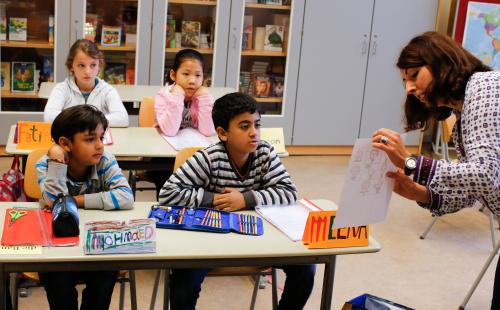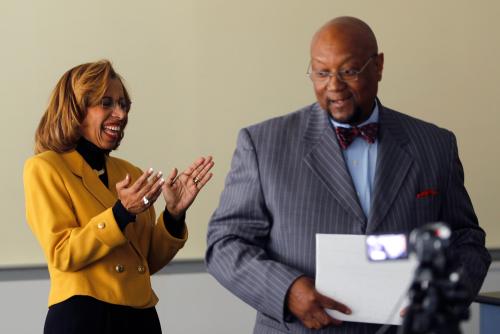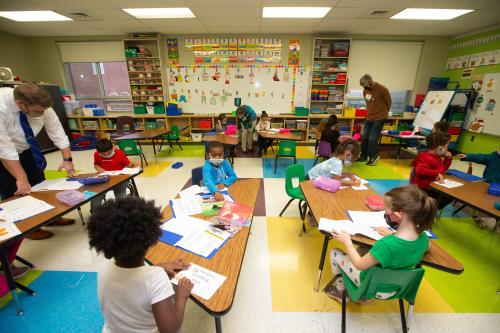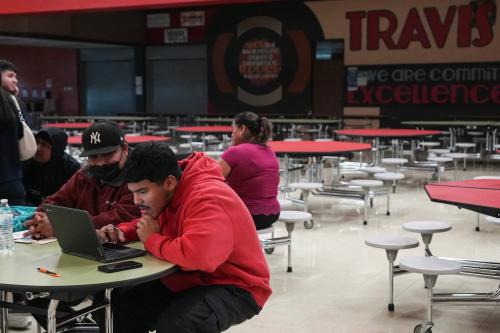For the last two decades, policymakers have understood “accountability” in K-12 education to mean something very specific: formal consequences for schools and/or educators based on student outcomes (typically test scores). Outcome-based accountability in the form of high-stakes testing has been the primary policy lever used to promote school performance. The Every Student Succeeds Act creates opportunities for policymakers to re-imagine accountability in schools—and not only by incorporating additional measures of student success into outcome-based accountability regimes.
Accountability exists in other forms that are common outside of K-12 schooling. Elected officials are accountable through the ballot box. Bureaucrats are accountable through rules and regulations. Doctors and lawyers are accountable through professional standards. Consumer-serving firms are accountable through the market. In fact, school choice initiatives such as those promoted by the new administration can be viewed as efforts to inject more market-based accountability into schooling. As my co-authors and I discuss in a recent paper, these varied forms of accountability reflect the fact that, psychologically, accountability can be created in several different ways.
Behavioral science has identified four discrete accountability mechanisms: evaluation, identifiability, reason-giving, and the mere presence of another. Good professional accountability practices will employ all four behavioral mechanisms, though in various ways. Consider the practice of medicine: Doctors must pass a series of exams to be certified for practice (evaluation); board certifications for specializations are publicly reported (identifiability); medical rounds require doctors to explain cases and treatment plans to their colleagues (reason-giving); and surgery is conducted with other hospital staff attending (mere presence of another). These professional accountability systems not only maintain standards of practice but also help professionals improve their practice.
Outcome-based accountability in education, on the other hand, fails to use all forms of accountability. High-stakes testing uses two mechanisms to create accountability—identifying schools and evaluating them—but does not employ reason-giving or the presence of another. And by itself, it provides no tools to help educators improve their practice. As I argue in a new paper, professional accountability could be used in schools alongside other forms of accountability to promote a cycle of continuous improvement.
Historically, professional accountability was used in K-12 schools only to set unambitious minimum standards. Happily, this is changing. Many innovative schools around the country are raising standards and creating professional accountability with approaches that make instructional practice more transparent, redesign educators’ jobs, or incorporate client feedback.
Professional accountability through transparency of practice
One of the hallmarks of professional accountability is transparency of practice, which induces accountability through (at least) the mere presence of another. Improving the rigor and utility of observations of classroom practice has been the most prominent method of promoting professional accountability through transparency over the last few years. In schools across the country, crude checklists have been replaced by detailed rubrics that expect observers to have substantial expertise in instructional techniques and provide useful feedback to teachers.
To be sure, there are concerns about observation measures: Rating scores are often implausibly high; scores may be biased by the students in the classroom; and observations can be costly and labor-intensive. Nonetheless, despite these limitations, there is evidence that they can produce improvements in student achievement. Observations may have value for enhancing accountability and thus improving practice even if the measurements they produce are imperfect.
Transparency of practice may be most powerful if it is routine, and not only associated with formal evaluations. In the Propel charter school network in southwestern Pennsylvania, teachers don’t miss a beat when the principal enters the classroom, because they see the principal in classrooms every day—for the purpose of supporting instruction. Meanwhile, Kansas City’s Kauffman Charter School is literally increasing the transparency of instructional practice by installing walls of windows that make classrooms visible to any adult in the hallway.
Observations need not—and should not—be conducted only by principals. Some schools are using peer feedback and observation, with promising results. New York City’s TEP Charter School—which has produced large achievement gains for its students—expects its teachers to observe each other twice every week, in the belief that the practice of observation benefits observed and observing teachers alike.
Professional accountability through job redesign
Peer observations could be part of a larger professional accountability system that involves differentiating the responsibilities of effective teachers to extend their influence. Career advancement opportunities for teachers in American schools have typically been rare. The establishment of instructional coaching positions is creating new career paths for expert teachers—often with positive results for students.
Schools that are implementing the Opportunity Culture program are promoting professional accountability by differentiating teachers’ jobs so that the most-effective teachers reach larger numbers of students (and are compensated more). In principle, shifting class sizes so that better teachers serve more students could be an advantage for all: Every student would have either a great teacher or a small class. TEP Charter School has somewhat larger classes than other New York City charter schools—in order to pay its teachers $125,000 salaries. Its teachers collaborate to create their own professional development for six weeks every summer.
Professional accountability through input from clients
Client voice is an implicit element of professional accountability in many fields. Some educator evaluation systems are beginning to incorporate feedback from clients. Districts such as Pittsburgh Public Schools are using student input as a component in teacher evaluations, just as colleges and universities do. Research shows that students can identify good teaching—and after all, unlike principals or peers, students observe their teachers every single day.
Client input is relevant for principals as well. Indeed, along with parents and students, teachers can be viewed as clients of principals. Input from subordinates is commonly a part of “360” evaluations in the business world. The Vanderbilt Assessment of Leadership in Education, now being used in hundreds of schools across the country, includes a survey of teachers to provide input in the principal’s evaluation.
A future of continuous improvement
It is time for accountability in education to be liberated from its narrow association with high-stakes testing. A single-minded focus on one form of accountability overlooks opportunities to create a rich system of incentives and supports that employs multiple accountability tools to promote improved practice. Initiatives that increase the transparency of educational practice, redefine instructional positions to extend the influence of the most effective teachers, and incorporate input from clients would enhance educator accountability.
In concert with outcome-based and market-based accountability, these forms of professional accountability could create a system of continuous improvement in schools. Over time, they might also raise the status and esteem of the teaching profession.






Commentary
Redefining accountability to treat teachers and leaders like the professionals they are
April 13, 2017